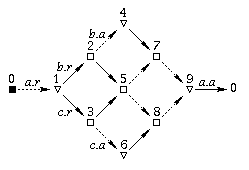The E-Element is useful in decompositions to preserve symmetry and to postpone further design decisions (express further design freedom), [Verhoeff98, 176-177]. For an example see the Decision-Wait.


Specification in DI Algebra:
NAME = "E-element"
I = { r?, a0?, a1? }
O = { a!, r0!, r1! }
E = [r? -> Er, else -> CHAOS]
Er = [r0! -> Er0
,r1! -> Er1
,else -> CHAOS
]
Er0= [a0? -> r1!;F0, r1! -> F, else -> CHAOS]
ND [a0? -> r1!;F0, else -> CHAOS]
Er1= [a1? -> r0!;F1, r0! -> F, else -> CHAOS]
ND [a1? -> r0!;F1, else -> CHAOS]
F = [a0? -> F0, a1? -> F1, r? -> CHAOS]
F0 = [a1? -> a!;E, else -> CHAOS]
F1 = [a0? -> a!;E, else -> CHAOS]
Also available through this link
The roles of the b and c ports can be interchanged:
E(a; b, c) = E(a; c, b)
The E-Element satisfies Rules Y' and Z'. It is not output deterministic since states 2 and 3 are indifferent and have outgoing output arrows. The output nondeterminism is static.
No information available
No information available
No information available